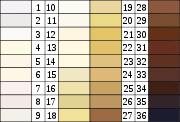
Von Luschan's chromatic scale
Encyclopedia

Felix von Luschan
Felix Ritter von Luschan was an Austrian doctor, anthropologist, explorer, archaeologist and ethnographer.Note that the Ritter is not part of the name but a title, equivalent to the English knight or baronet.-Life:...
. The equipment consists of 36 opaque glass tiles which were compared to the subject's skin, ideally in a place which would not be exposed to the sun (such as under the arm). The von Luschan scale was used to establish racial classifications of entire cognate population
Population
A population is all the organisms that both belong to the same group or species and live in the same geographical area. The area that is used to define a sexual population is such that inter-breeding is possible between any pair within the area and more probable than cross-breeding with individuals...
s according to skin color.
The von Luschan scale was used extensively throughout the first half of the 20th century in race studies and anthropometry
Anthropometry
Anthropometry refers to the measurement of the human individual...
. However, it was considered problematic, even by its practitioners, because it was very inconsistent. In many instances, different investigators would give different readings of the same person.
The von Luschan scale was largely abandoned by the early 1950s, replaced instead by methods utilizing reflectance spectrophotometry
Spectrophotometry
In chemistry, spectrophotometry is the quantitative measurement of the reflection or transmission properties of a material as a function of wavelength...
.
Fitzpatrick scale
A less finely tiered scale of six skin types, called the Fitzpatrick scaleFitzpatrick scale
The Fitzpatrick Scale is a numerical classification schema for the color of skin. It was developed in 1975 by Thomas B. Fitzpatrick, a Harvard dermatologist, as a way to classify the response of different types of skin to UV light...
, was introduced in 1975 by Harvard dermatologist Thomas B. Fitzpatrick
Thomas B. Fitzpatrick
Thomas B. Fitzpatrick was a Chairman of the Department of Dermatology at Harvard Medical School and Chief of the Massachusetts General Hospital Dermatology Service from 1959 to 1987....
to describe the sun tanning
Sun tanning
Sun tanning or simply tanning is the process whereby skin color is darkened or tanned. The process is most often a result of exposure to ultraviolet radiation from the sun or from artificial sources, such as a tanning bed, but can also be a result of windburn or reflected light...
behaviour of various skin types, without any racial classification connotations, as follows:
| Type | von Luschan scale | Also called |
|---|---|---|
| I | 1–5 | Very light or white, "Celtic" type |
| II | 6–10 | Light or light-skinned European |
| III | 11–15 | Light intermediate, or dark-skinned European |
| IV | 16–21 | Dark intermediate, also "Mediterranean" Mediterranean race The Mediterranean race was one of the three sub-categories into which the Caucasian race and the people of Europe were divided by anthropologists in the late nineteenth and early twentieth centuries, following the publication of William Z. Ripley's book The Races of Europe... or "olive skin Olive skin Olive skin describes a skin color range of some indigenous individuals who are from the Mediterranean and some other parts of Europe, Middle East and regions of South Asia, Southeast Asia and Central Asia. It may often be skin type 3 and 4 on the Fitzpatrick scale. However, this scale measures... " |
| V | 22–28 | Dark or "brown Brown people Brown people or brown race is a political, racial, ethnic, societal, and cultural classification, similar to black people and white people. Like these, it is a metaphor for race based on human skin color, reflecting the fact that there are shades of skin colour intermediate between "Mediterranean" ... " type |
| VI | 29–36 | Very dark or "black Black people The term black people is used in systems of racial classification for humans of a dark skinned phenotype, relative to other racial groups.Different societies apply different criteria regarding who is classified as "black", and often social variables such as class, socio-economic status also plays a... " type |
Further reading
- von Luschan F (1897). Beiträge zur Völkerkunde der Deutschen Schutzgebieten. Berlin: Deutsche Buchgemeinschaft.
- von Luschan F (1927). Völker, Rassen, Sprachen : Anthropologische Betrachtungen. Berlin: Deutsche Buchgemeinschaft.
External links
- Von Luschan's Chromatic Scale (at bottom) and other anthropometric instruments at the Natural History Museum of Florence

